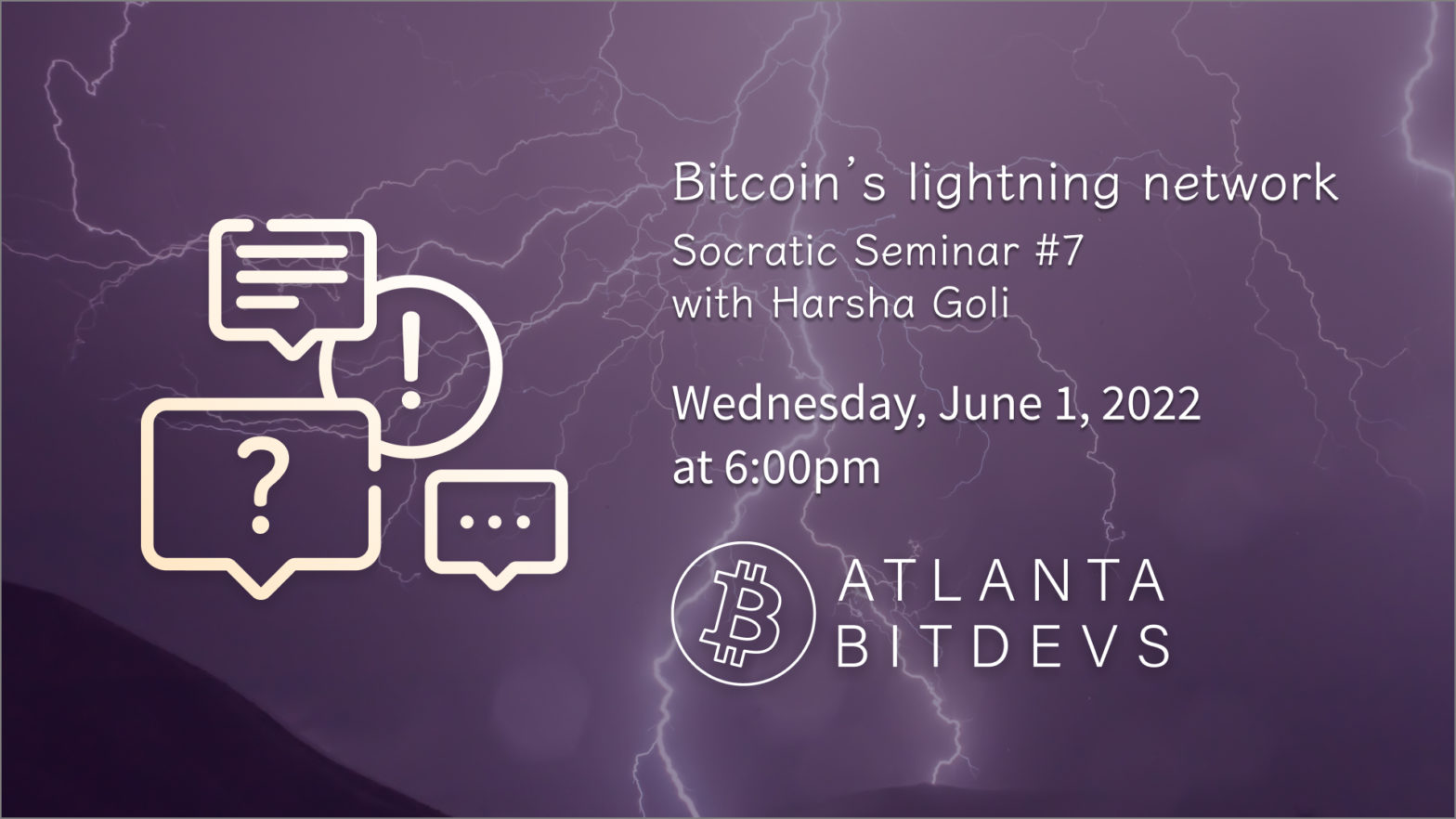It’s almost time for Bitcoin Socratic Seminar #7!
What is a Socratic Seminar?
Inspired by other BitDevs meetups around the US, our Socratic Seminar events are formatted to foster debate, information sharing and lively discussion.
- Discussion topics are provided ahead of the event
- The event moderator(s) leads the audience through the topics
- Raise your hand to grab the mic and participate in the conversation
- We go to a bar afterwards
Opening Presentation
We’ll start off with special announcement for the Atlanta community.
Discussion Topics

Then, we’ll have an open discussion about the bitcoin lightning network with Harsha Goli, an engineer at Lightning Labs. What does lightning do? Why does it matter? What are the latest technological advancements in lightning? And what new things should be looking out for?
Intro to the Lightning Network
We’ll do a brief catch-up on what the lightning network is and describe some of the current issues that need to be working on in lightning.
If you’re new to lightning network, consider looking at these resources:
Simplified overview of liquidity on the lightning network for product designers
Technical overview of lightning from Andreas Antonopoulos:
CashApp supports zero amount invoices
A zero-amount invoice is literally a lightning invoice with no amount defined. This means the sender can pay whatever value to the invoice they like.
Zero-amount invoices have been problematic in Lightning. Previously, there were security vulnerabilities. Those have been fixed with most implementations. However, not every lightning wallet. offers support for zero-amount. While zero-amount invoices can still only be safely used once, they arguably provide a better UX by allowing recipients to not have to define an amount if they don’t care about the amount.
CashApp recently announced support for zero-amount invoices here:
Add the ability to hold HTLCs before forwarding
A lightning node needs to be online in order top receive a payment. This can be problematic for lightning nodes running on mobile devices, because the node will effectively go offline when the user puts their phone to sleep and places in their pocket, purse, etc. This can become even trickier when both the sender and recipient are lightning nodes on mobile devices.
Matt Corallo proposed a solution for this. The basic idea involves letting LSPs (Lightning Service Providers) temporarily hold the HTLC (an in-flight lightning payment) while the recipient is offline. The HTLC is released when the recipient’s LSP passes a specific nonce back to the sender’s LSP.
Pickhardt Payments
When sending a lightning payment, a node must calculate a path through the lightning network that will both reach the intended recipient and has enough liquidity to route the payment. Finding a path may become a more complicated problem as the lightning network continues to grow, both in terms of mathematical complexity and finding enough liquidity.
Pickhardt Payments are a potential solution to this. Back in March, we discussed how Rene Pickhardt computed a multi-path payment flow over the Lightning network in 0.65 seconds [1,2].
In the past month, there has been a lot of momentum for this new pathfinding method.
- Invitation to test our research on probabilistic and optimal payment flows
- Pickhardt Payments implemented in lnd-manageJ
TARO – Tokens on Lightning
TARO is Taproot Asset Representation Overlay. Lightning Labs proposed this idea around the time of Bitcoin 2022. This idea utilizes taproot to represent assets on bitcoin. These assets could then be shared over the lightning network.
For technical details, see the Lightning Dev Mailing List post.
For a higher level overview, read this Bitcoin Magazine article.
Watch this video if you’d like to hear Roasbeef explain TARO.

